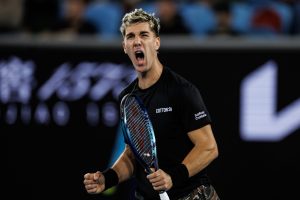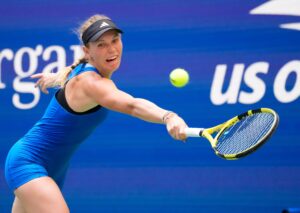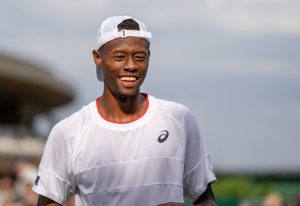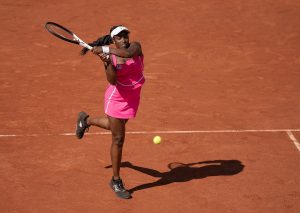Our resident tennis historian, Martin Keady, looks back at the five finest Australian Open Men’s Singles Champions.
The stature of the five finest Australian Open Men’s Singles Champions can be judged by those great players who don’t make the list, including such all-time greats as Rod Laver, Rafael Nadal and Pete Sampras. Indeed, some of the finest male tennis players ever, including Bjorn Borg and John McEnroe, did not manage to win the Australian Open even once. All of which puts into context the immense achievements of the men who do make this list. Here, then, are the five finest Australian Open Men’s Champions.
5. ANDRE AGASSI (Winner of four Australian Opens: 1995, 2000, 2001 and 2003 )
Three men have won the Australian Open four times. As a result, in purely numerical terms it is impossible to divide them. Instead, it is necessary to consider how they won those titles: in what style, and over what period of time, to establish whether they ever achieved a period of dominance in Melbourne. On that basis, Andre Agassi just edges out the great Australian champion, Ken Rosewall, whose four Australian titles were won over a near twenty-year period, with two in the 1950s (1953 and 1955) and – astonishingly – two in the early 1970s (1971 and 1972), when Rosewall returned to the Majors in the Open era (post-1968). By contrast, Agassi won his four Australian Opens within a single decade, with three of them coming in four years between 2000 and 2003.
Agassi’s first Australian Open win was in 1995 and it was certainly his greatest, simply because of the calibre of the opponent who he faced in the final, his fellow American and arch-rival for much of his career, Pete Sampras. Sampras was actually on course to retain the Australian title, having won it a year earlier, but Agassi, having already succumbed to Sampras so often throughout their careers, was determined to triumph in Melbourne. Sampras may have been virtually unbeatable on the grass of Wimbledon, which was ideally suited to his classical serve-volley game, but on a hardcourt, such as the one in Melbourne, Agassi’s fabulous return of serve was a much more potent weapon. He duly won in four sets, in what proved to be his only successful Major final against Sampras.
It has to be acknowledged that the three other men who Agassi beat in the early noughties to win the Australian Open final were not in the class of Sampras. Nevertheless, like Sampras in 1995, Russia’s Yevgeny Kafelnikov was the defending champion when Agassi beat him in 2000, and the following year Agassi retained his Australian title by defeating France’s Arnaud Clément in straight sets. That would prove to be the only time that Agassi, for all his extraordinary ability, retained a Major title in his career. He might have gone further and claimed a hat-trick of Australian titles but he was forced to miss the 2002 tournament due to injury. However, he made up for lost time the following year when he defeated Germany’s Rainer Schüttler in the final, not just in straight sets but for the loss of only five games overall, in one of the most one-sided Grand Slam finals ever.
Having won half of his total of eight Majors in Melbourne, Agassi often joked that he was “half-Australian” and certainly the Australian Open was incredibly good to him. In four years, he did not lose a single match on court and he only finally succumbed to defeat in a classic five-set semi-final against the mercurial Marat Safin in 2004. In effect, that was the beginning of the end for Agassi, not only in Australia but in tennis as a whole, as he never reached another Grand Slam final and eventually retired in 2006.
4. JACK CRAWFORD (Winner of four Australian titles: 1931, 1932, 1933 and 1935)
John Herbert Crawford, or “Jack” as he was known, is the third man to have won four Australian titles and is ranked just ahead of Andre Agassi on this list because he managed what injury prevented Agassi from doing and won a hat-trick of titles between 1931 and 1933.
Like so many pre-war champions, Crawford is largely forgotten today but he is absolutely deserving of his place in tennis history, and in particular the history of his home Grand Slam, for two main reasons. First, unlike most great Australian players throughout the 20th century, both male and female, he was not a serve-volleyer but a baseliner, whose style of play was more about sublime technical ability than sheer power.
Secondly, in addition to winning his hat-trick of Australian titles, Crawford also achieved another extraordinary trilogy of wins in 1933, when he became the first man to win the first three Majors of the year and seemed set to win the Grand Slam of all four Majors, which at the time was considered almost impossible to achieve. Crawford went extremely close, reaching the final of the US Championships in New York and even leading his opponent, Britain’s Fred Perry (who was appearing in his first Grand Slam final), by two sets to one, before losing the final two sets 6-0, 6-1. It is believed that Crawford, who suffered from asthma, was finally overcome by the extreme humidity of New York in high summer.
Crawford would go on to gain a modicum of revenge over Perry when he defeated him in the 1935 Australian final to claim his fourth Australian title. That was to be his last Major win and consequently he never came close to winning the Grand Slam again. That was finally achieved in 1938, when America’s Don Budge became the first man to win all four Majors in the same calendar year, a feat that has only been achieved twice more, by Rod Laver in 1962 and 1969. Consequently, the Grand Slam remains the elusive “holy grail” of men’s tennis, even in the current era of Federer, Nadal and Djokovic.
3. ROGER FEDERER (Winner of five Australian Opens: 2004, 2006, 2007, 2010 and 2017)
Before play began in Melbourne this week, Roger Federer expressed incredulity that he was considered the favourite to win the Australian Open Men’s Singles titles, on the basis that no 36-year-old should be considered the favourite for any tournament, let alone a Major. However, as he is in so many ways, Federer is the exception that proves the rule and having won in Melbourne so remarkably last year no sensible bookmaker would back against him.
Federer won the first of his five Australian titles in 2004, when he beat Marat Safin in the final in straight sets. It was an important win for him, as it was only his second Major victory after Wimbledon in 2003 and proved that he was not only a great player on grass but almost equally adept on hardcourt. A year later in Melbourne, Safin defeated Federer in one of the great Australian Open semi-finals, winning 9-7 in the fifth set and going on to win the title. However, in both 2006 and 2007 Federer was invincible in Melbourne, defeating Marcos Baghadatis of Cyprus and Fernando González of Chile in succession, for the loss of just one set in two finals.
Then began what can reasonably be described as the “Djokovic Era” in Australia (for more of which, see below), as Djokovic first defeated Federer in straight sets in the semi-final in 2008 and then claimed his maiden Major victory by beating Jo-Wilfried Tsonga in the final. Worse was to follow for Federer in 2009, when Rafael Nadal defeated him in the final in five sets, backing up his remarkable 2008 Wimbledon triumph over Federer by beating him on his second most favoured surface, hardcourt. As Federer wept only at the end of the match, it appeared that his two younger rivals, Nadal and Djokovic, had broken his stranglehold on the men’s game.
Of course, to some extent they had, as even the sublime Swiss could never quite regain the dominance he had enjoyed between 2003 and 2008, in what now appears to have been the truly “imperial” (or nearly unbeatable) phase of his career. Nevertheless, being Federer he would ultimately adapt brilliantly to the challenges provided by his two great rivals, and if he would never again achieve the almost unimaginable heights of the early part of his career he would still go on to win several more Majors, including two in Australia.
The first of those two Melbourne triumphs came in 2010, when he defeated Britain’s Andy Murray in the final in straight sets (albeit that the third set went to a tie-break that Federer eventually won 13-11). Even more impressive, however, was the 2017 triumph, when he rolled back the years as only the very greatest sportsmen or women, or artists, can and defeated Nadal in a Grand Slam final for the first time in a decade, in the process producing some of the finest tennis that he has ever played.
Federer has fondly reminisced about that astonishing turnaround this week, in particular the surge of brilliance in the fifth and final set in 2017 that took him from 3-1 down to win 6-3. If he can get anywhere near those almost ridiculous heights again this year, then, whatever his age, he will be the man to beat.
2. NOVAK DJOKOVIC (Winner of six Australian Opens: 2008, 2011, 2012, 2013, 2015 and 2016)
The current era of men’s tennis is, quite justifiably, regarded as the finest ever in the history of the sport, ahead even of such legendary periods as the Borg-McEnroe-Connors era of the 1970s and early 1980s. Throughout it, “the Big Three” (apologies to Andy Murray, but having won only three Majors he cannot legitimately be considered to have matched their achievements) have made one of the Majors almost their “home” Major, in that they have achieved almost total dominance over it. For Federer, with his eight titles on the grass of London SW19, it has been Wimbledon; for Nadal, with his scarcely believable 10 titles at Roland Garros, it has been the clay of Paris; and for Novak Djokovic it has been the hardcourt of Melbourne. (Federer, of course, also won five US Opens in a row between 2004 and 2008, meaning that, at his best, he had almost two home Majors that he mercilessly triumphed in.)
Djokovic’s first Australian Open victory came in 2008 but it was not the complete breakthrough that many people, presumably including Djokovic himself, thought it would be. In fact, it was to be another three years before he would win his second Major, again in Melbourne, and only then after he had switched to the gluten-free diet that finally enabled him to overcome the physical problems, particularly cramping, that had plagued the early part of his career.
Djokovic’s 2011 triumph in Melbourne came against Andy Murray and in total four of his six winning finals in Australia have been against the Scot, who in the process set the completely unwanted record of losing the same Grand Slam final five times (having also lost to Federer in 2010). None of those four finals were particularly memorable, with not one of them going to five sets and only two going to even four sets, although it has to be acknowledged that the 2013 final began with two fiercely contested tiebreaks, with Murray winning the first, before Djokovic eventually romped home.
Instead, it is the 2012 Australian Open final, when Djokovic defeated Rafael Nadal, that almost alone merits Djokovic’s inclusion as one of the very greatest Australian Open champions and indeed one of the greatest Grand Slam champions of them all. Less than six months earlier, Djokovic had defeated Nadal at the 2011 US Open final, for his third Major title that year, in what was itself a minor classic. However, it was only the hors d’oeuvre to the feast that was the 2012 Melbourne final, as Djokovic and Nadal fought it out over five sets and more than six hours, in what remains the longest Grand Slam final of the Open era (which now extends to more than half a century), before Djokovic finally won the fifth set 7-5.
That final is particularly important, not only for Djokovic but for tennis as a whole, when one considers what the chairman of the ATP, Chris Kermode, said at the end of 2017. Kermode, who was a brilliant tournament director at Queen’s before assuming overall administrative control of the men’s game, had openly questioned whether in the future anyone would want to watch a “six-hour final”. Well, when they’re as good as the 2012 Australian Open final, the answer is absolutely, “Yes”, and in the era of “tiebreak 10s” and other shortened formats, everyone in the game, especially those running it, should remember that.
1. ROY EMERSON (Winner of six Australian Championships: 1961, 1963, 1964, 1965, 1966 and 1967)
For all his achievements in Melbourne, not least winning that titanic 2012 final, Novak Djokovic is just edged out as the All-time Greatest Australian Open Men’s Champion by Australia’s own Roy Emerson. That is because although both men have won six times in Melbourne, Emerson won five titles in a row between 1963 and 1967, whereas Djokovic is yet to win even three Australian titles in succession.
However, it could be argued that the real contender to Emerson’s crown of All-Time Greatest Australian Open Champion is not Djokovic but another Australian, the immortal Rod Laver. That is because for most of the 1960s, when Emerson was at his peak as a player (especially in Australia), he rarely if ever played Laver. That was because Laver, having won the first of his two Grand Slams in 1962, had duly turned professional and consequently was unable to play again at the Majors until tennis finally, belatedly went fully professional in 1968, at which point Laver returned to the Majors and duly won his second Grand Slam in 1969.
It may appear churlish to question Emerson’s achievements in this way, but ultimately it is inevitable, because the tennis world will never know what would have happened if Laver, like Emerson, had remained an amateur. It is probable that it would have been Laver, not Emerson, who went on to set a record for the number of Majors won by a man. As it was, Emerson set the all-time tally at 12, a record that was finally only overcome by Pete Sampras, who won 14 Majors before he retired, and then subsequently bested again by Roger Federer (who is currently on 19 Major wins) and Rafael Nadal (16).
However, putting aside all that “alt” or alternative history, Emerson was undoubtedly a great player in his own right. He had actually beaten Laver several times before “Rocket” Rod turned pro, winning in four sets in the final of the 1961 Australian Championship and also beating him in the final of the US Championships later that year. Laver reversed the 1961 Australian result the following year, when he beat Emerson in the final in four sets, although Emerson did achieve the remarkable feat of “bagelling” Laver 6-0 in the second set, which was one of the very few times in his career – amateur or professional – when Laver did not win even a single game in a set.
Thereafter, Emerson beat rather less stellar compatriots in the Melbourne final, first defeating Ken Fletcher in 1963 and then beating Fred Stolle in both 1964 and 1965. The last two of his five winning finals in a row were against the young Arthur Ashe, who he beat fairly comfortably in both 1966 and 1967.
Emerson did not make a successful transition from the amateur era to the Open era, at least not in singles. He followed up his fifth and final Australian win in 1967 by winning at Roland Garros a few months later, but thereafter he faltered somewhat as Laver and other great players such as Lew Hoad returned to the tennis tour proper and rather swept him aside. Nevertheless, he continued to play doubles to a high level, even winning his final Grand Slam Doubles title (one of a remarkable 16 in total) in 1971 alongside Laver, and only finally retired from professional tennis in 1983, an incredible thirty years after his playing career had begun.
Thus Roy Emerson remains something of an enigma, or perhaps a paradox. He is simultaneously the “winningest” man ever in Melbourne and the man whose career, for all its undoubted achievements, was ultimately overshadowed by that of Rod Laver, the man who, if he had not turned professional and thus missed out on the opportunity to play in the game’s Major events, might have set a record of Grand Slam singles wins that even the great Roger Federer would have struggled to match.
Main Photo:






